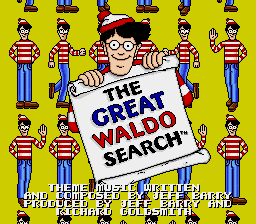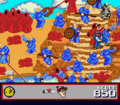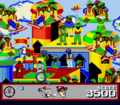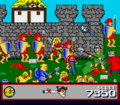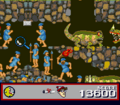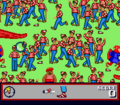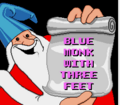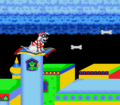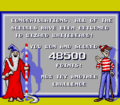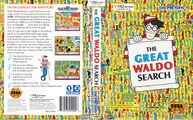Difference between revisions of "The Great Waldo Search"
From Sega Retro
Scarred Sun (talk | contribs) m (Text replacement - "Physical Scans" to "Physical scans") |
|||
| Line 45: | Line 45: | ||
:'''Theme music''': Jeff Barry | :'''Theme music''': Jeff Barry | ||
}} | }} | ||
| − | ==Physical | + | ==Physical scans== |
{{Ratings | {{Ratings | ||
| icon=MD | | icon=MD | ||
Revision as of 10:22, 19 March 2016
| The Great Waldo Search | |||||
|---|---|---|---|---|---|
| System(s): Sega Mega Drive | |||||
| Publisher: THQ | |||||
| Developer: Radiance Software | |||||
| Sound driver: GEMS | |||||
| Genre: Puzzle | |||||
| Number of players: 1 | |||||
|
The Great Waldo Search is a 1992 search game based on the 1989 book of the same name by British illustrator Martin Hanford. The game was produced by American-based developer Radiance Software and published by THQ for the Nintendo Entertainment System, Super NES and Mega Drive.
Gameplay
The player is tasked with finding Waldo, a man with a red-and-white striped shirt and cap, along with a scroll for the Wizard Whitebeard, in each of the game's five levels. The levels themselves—The Battling Monks, The Carpet Flyers, The Unfriendly Giants, The Underground Hunters and The Land of Waldos—are each based on pages of artwork from The Great Waldo Search book. Players use the d-pad to move a magnifying glass across the screen, scrolling left and right. Holding down the ![]() button increases the scroll rate on the magnifying glass. To find an item, place the magnifying glass over the object and press
button increases the scroll rate on the magnifying glass. To find an item, place the magnifying glass over the object and press ![]() . If it is an object, the player will get the item; if not, a buzzer will sound and the level's timer will decrease. Pressing
. If it is an object, the player will get the item; if not, a buzzer will sound and the level's timer will decrease. Pressing ![]() pauses the game, with the level out of view.
pauses the game, with the level out of view.
In addition to Waldo (worth 1500 points) and Whitebeard's scroll (worth 1000 points), there are other objects available for the player to find. Locating Woof, a dog wearing the same red-and-white pattern, as Waldo, opens a minigame where the player flies on a carpet, collecting bones worth 100 points each. 150-point tiles give the player an additional 150 points. Locating a clock increases the time left on the level. However, some clocks give a clue for the player to find an additional item (a man with a red beard, a soldier with two spears, etc.) Finding these clues gives the player 750 points. Any extra time at the end of the level earns additional points.
The game has two modes, normal and expert. In expert mode, objects are more well-hidden, and clocks with clues give one text clue instead of having the clue over audio clip. Completing all five levels ends the game.
Gallery
Production Credits
- Programmed by: Richard Young
- Produced by: Jeff Barry, Richard Goldsmith, Radiance Software
- Artists: Wendy Salin, Maurice Morgan, Kevin Kirk
- Music: Doug Brandon
- Theme music: Jeff Barry
Physical scans
| Sega Retro Average | |||||||||||||||||||||||||||||||||||||||
|---|---|---|---|---|---|---|---|---|---|---|---|---|---|---|---|---|---|---|---|---|---|---|---|---|---|---|---|---|---|---|---|---|---|---|---|---|---|---|---|
|
| 50 | |
|---|---|
| Based on 7 reviews | |
- ↑ 1.0 1.1 File:SegaForce UK 16.pdf, page 101 Cite error: Invalid
<ref>tag; name ":File:SegaForce UK 16.pdf_p101" defined multiple times with different content - ↑ 1700 igr dlya Sega, "" (RU; 2001-xx-xx), page 131
- ↑ Game Power, "Settembre 1993" (IT; 1993-0x-xx), page 98
- ↑ Sega Mega Drive Advanced Gaming, "March 1993" (UK; 1993-xx-xx), page 20
- ↑ Mega, "April 1993" (UK; 1993-03-18), page 54
- ↑ Supergame, "Maio 1993" (BR; 1993-05-xx), page 18
- ↑ Tricks 16 bit, "Tricks Sega Gold 800 igr" (RU; 1998-03-20), page 83
